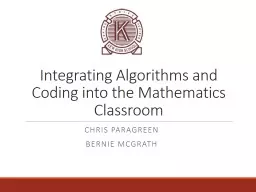

into the Mathematics Classroom Chris paragreen Bernie mcgrath IT subjects at KHS No standalone subjects until Yr 10 Teaching of ICT integrated into the curriculum Design technologies covered in the Arts ID: 627612
Download Presentation The PPT/PDF document "Integrating Algorithms and Coding" is the property of its rightful owner. Permission is granted to download and print the materials on this web site for personal, non-commercial use only, and to display it on your personal computer provided you do not modify the materials and that you retain all copyright notices contained in the materials. By downloading content from our website, you accept the terms of this agreement.
Slide1
Integrating Algorithms and Coding into the Mathematics Classroom
Chris paragreenBernie mcgrathSlide2
I.T. subjects at KHS
No stand-alone subjects until Yr 10Teaching of ICT “integrated into the curriculum”
Design technologies covered in the Arts
Excel taught within some Maths units
At Yr 10 we offer programming and robotics
Digicon 2017 - Integrating Algorithms and Coding into the Mathematics Classroom
2Slide3
Algorithms
Level
Content Description
7
Design and implement mathematical algorithms using a simple general purpose programming language
8
9
10
Level
Elaborations7finding the sum of a set of consecutive numbers using a loop structureconstructing geometric patterns such as a honeycomb, using dynamic geometry functionality
LevelElaborations8debugging search and sort programstesting a number for divisibility
LevelElaborations9using a sort algorithm to determine the median of a set of numbersexploring variation in proportion and means of random samples, drawn from a population
LevelElaborations10using two-dimensional arrays such as matrices to represent and implement sequences of transformations of sets of points in the planeusing pointers in algorithms
Use algorithms and related testing procedures to identify and correct
errors
Apply set structures to solve real-world problems
Implement algorithms using data structures in a general-purpose programming language
Digicon 2017 - Integrating Algorithms and Coding into the Mathematics Classroom
3Slide4
Digital Technologies
Level
Content Description
7
Design algorithms represented diagrammatically and in English, and trace algorithms to predict output for a given input and to identify errors
8
9
10
Level
Elaborations7investigating and designing some common algorithms, such as to search, sequence, sort, merge and control data structureschecking the accuracy of an algorithm before it is implemented, for example desk checking it with test data to see if the instructions produce the expected results
Develop and modify programs with user interfaces involving branching, iteration and functions using a general-purpose programming languageDesign algorithms represented diagrammatically and in structured English and validate algorithms and programs through tracing and test casesDevelop modular programs, applying selected algorithms and data structures including using an object-oriented programming language Digicon 2017 - Integrating Algorithms and Coding into the Mathematics Classroom
4LevelElaborations7using diagrams to describe key decisions, for example creating flowcharts using digital systems to describe a set of computational instructionsusing structured English to express algorithmic instructions, for example using conventional statements such as ‘while’ and ‘
endwhile’ in a ‘while loop’ when describing interactive instructionLevelElaborations8developing and modifying digital solutions by implementing instructions contained in algorithms using a programming language
developing a digital game that manipulates models of real-world objects
programming a robot to recognise particular objects and to treat them differently, for example to choose objects based on colour
Level
Elaborations
8
creating digital solutions that provide user navigation and prompts with controlled repetitions, for example an information kiosk that has layers of buttons and prompts the user three times before returning to the beginning
Level
Elaborations
9
designing algorithms to solve real-world problems and describing algorithms using flow charts and structured English, for example START, END, IF and UNTIL
recognising that different algorithms can solve a problem with different trade-offs
Level
Elaborations
9
tracing algorithms to predict results and program state for a given input, for example desk checking or using an interactive debugging tool
using tracing techniques to test algorithms, for example desk checking an algorithm for a given input by stepping through the algorithm while keeping track of contents of the variables
Level
Elaborations
10
coding separate modules that perform discrete functions but collectively meet the needs of the solution
defining classes that represent the attributes and behaviour of objects in the real world or in a game
selecting different types of data structures such as an array, record and object to model structured dataSlide5
Focus on Year 7
Level
Content Description
6A
Design algorithms involving branching and iteration to solve specific classes of mathematical problems
7A
Design and implement mathematical algorithms using a simple general purpose programming language
8A
Use algorithms and related testing procedures to identify and correct errors6DDesign, modify and follow simple algorithms represented diagrammatically and in English, involving sequences of steps, branching, and iteration
7DDesign algorithms represented diagrammatically and in English, and trace algorithms to predict output for a given input and to identify errors 8DDevelop and modify programs with user interfaces involving branching, iteration and functions using a general-purpose programming language Digicon 2017 - Integrating Algorithms and Coding into the Mathematics Classroom5Slide6
Focus on Year 7
6
Digicon
2017 - Integrating Algorithms and Coding into the Mathematics ClassroomSlide7
An algorithmin Measurement
7
https://scratch.mit.edu/projects/151149535/
Digicon
2017 - Integrating Algorithms and Coding into the Mathematics ClassroomSlide8
Teaching theCartesian Plane
https://scratch.mit.edu/projects/106729145/
Digicn
2017 - Integrating Algorithms and Coding into the Mathematics Classroom
8
Digicon 2017 - Integrating Algorithms and Coding into the Mathematics ClassroomSlide9
Transformationsand Iteration
https://scratch.mit.edu/projects/159322940/https://scratch.mit.edu/projects/118501335
/
9
Digicon
2017 - Integrating Algorithms and Coding into the Mathematics ClassroomSlide10
Forum
Questions?Comments?What’s your school doing?
10
Digicon
2017 - Integrating Algorithms and Coding into the Mathematics ClassroomSlide11
Thank you
11Digicon
2017 - Integrating Algorithms and Coding into the Mathematics Classroom